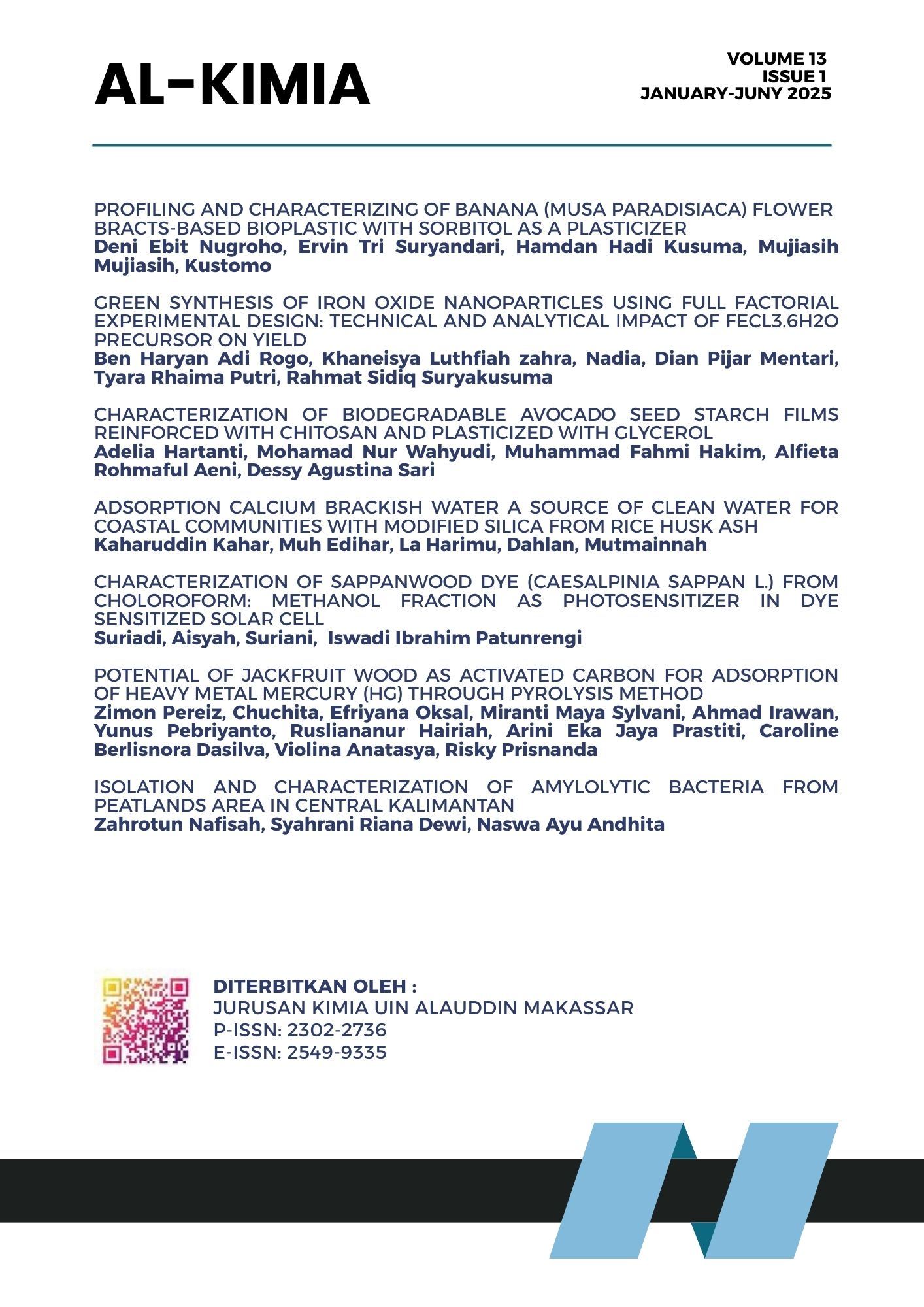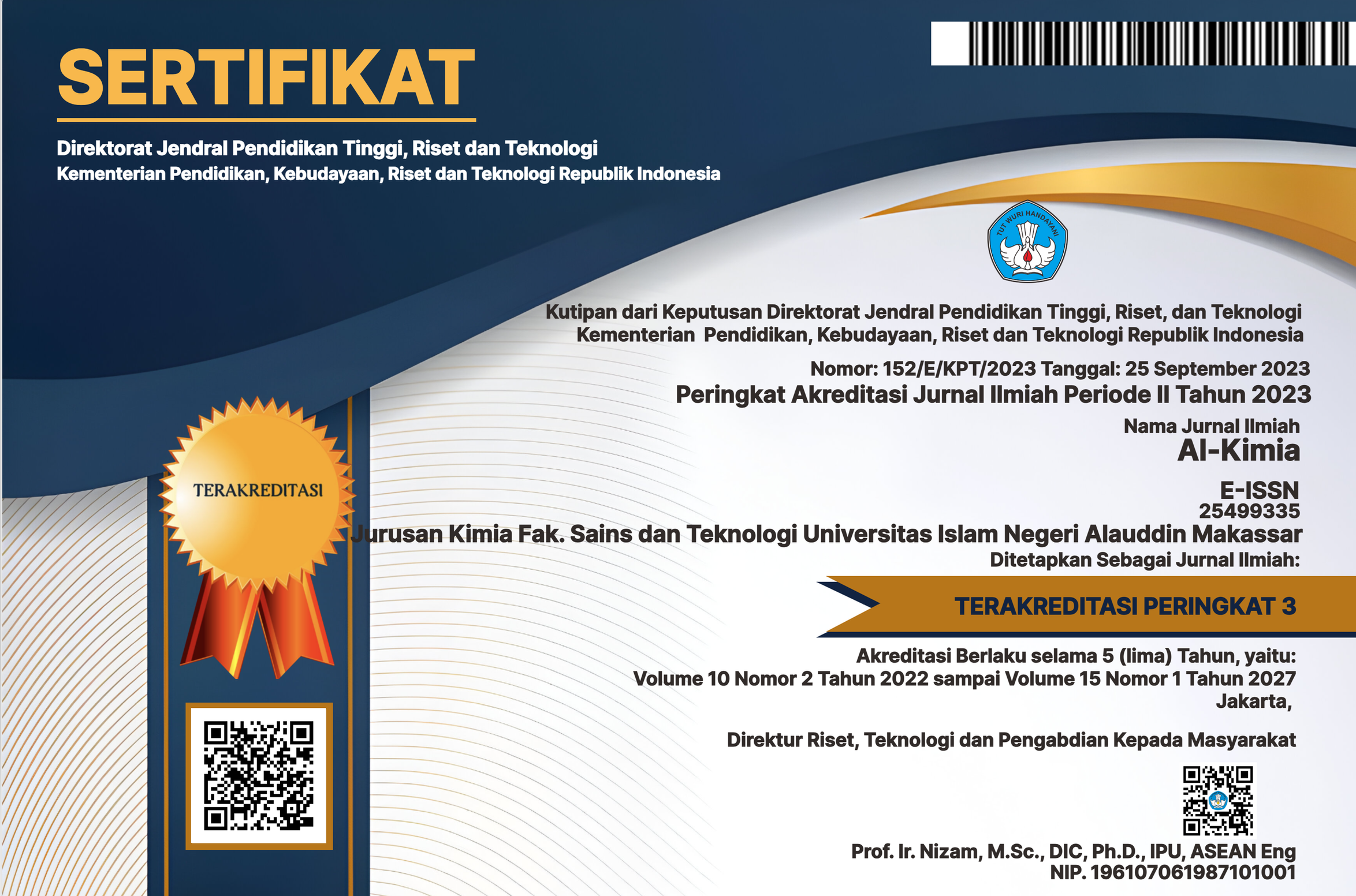Profiling and characterizing of banana (Musa paradisiaca) flower bracts-based bioplastic with sorbitol as a plasticizer
Keywords:
bioplastic, polyvinyl alcohol, banana flower bractAbstract
Banana flower bracts (BFB) are a promising source of starch as a bioplastic material. However, starch-based bioplastics products are primarily stiff and rigid to shape. Polyvinyl alcohol (PVA) may improve the elasticity and increase force resistance of starch-based bioplastics. Therefore, this study aims to analyze the characteristics and determine the optimal combination of BFB starch and PVA concentration for bioplastic production. The BFB were chopped and boiled until soft, soaked in sodium bisulfite solution for 30 minutes, and dried to produce fine powder. The powder was macerated in clean water for two days to produce starch, which was then combined with 0.5 chitosan and various concentrations of PVA. Physical characteristic tests, including Force, tensile strength, elongation, and biodegradation, were measured to determine the best composition. This study found the combination of 0.5 gr of BFB starch, 0.5 gr of chitosan, and 10 ml of PVA improved the capability of bioplastic to hold more than 13 N and tensile strengths up to 25 MPa. Furthermore, increasing BFB concentration is in line with enhanced durability; however, it reduces flexibility. Conversely, PVA significantly increased plasticity and elasticity while maintaining high biodegradability (61.2% per day).
Downloads
References
Ahsan, W. A., Hussain, A., Lin, C., & Nguyen, M. K. (2023). Biodegradation of different types of bioplastics through composting—a recent trend in green recycling. Catalysts, 13(2), 294. DOI: 10.3390/catal13020294
Amin, Md. R., Chowdhury, M. A., & Kowser, Md. A. (2019). Characterization and performance analysis of composite bioplastics synthesized using titanium dioxide nanoparticles with corn starch. Heliyon, 5(8), e02009. DOI: 10.1016/j.heliyon.2019.e02009
Amutha, K., Sudha, A., & Saravanan, D. (2022). Characterization of natural fibers extracted from banana inflorescence bracts. Journal of Natural Fibers, 19(3), 872–881. DOI: 10.1080/15440478.2020.1764437
Anugrahwidya, R., Armynah, B., & Tahir, D. (2021). Bioplastics starch-based with additional fiber and nanoparticle: characteristics and biodegradation performance: A review. Journal of Polymers and the Environment, 29(11), 3459–3476. DOI: 10.1007/s10924-021-02152-z
Aqlil, M., Moussemba Nzenguet, A., Essamlali, Y., Snik, A., Larzek, M., & Zahouily, M. (2017). Graphene oxide filled lignin/starch polymer bionanocomposite: structural, physical, and mechanical studies. Journal of Agricultural and Food Chemistry, 65(48), 10571–10581. DOI: 10.1021/acs.jafc.7b04155
Asrofi, M., Sapuan, S. M., Ilyas, R. A., & Ramesh, M. (2021). Characteristic of composite bioplastics from tapioca starch and sugarcane bagasse fiber: Effect of time duration of ultrasonication (Bath-Type). Materials Today: Proceedings, 46, 1626–1630. DOI: 10.1016/j.matpr.2020.07.254
Atika Adnan, N., Hanani Meriam Suhaimy, S., Arif Budiman Pauzan, M., & Fauzi, B. (2023). Effect of polyvinyl alcohol on cassava and potato starch plastic film: Mechanical, thermal and swelling properties. Enhanced Knowledge in Sciences and Technology, 3(2), 460–471. DOI: 10.30880/ekst.2023.03.02.052
Ayyubi, S. N., Purbasari, A., & Kusmiyati. (2022). The effect of composition on mechanical properties of biodegradable plastic based on chitosan/cassava starch/PVA/crude glycerol: Optimization of the composition using Box Behnken Design. Materials Today: Proceedings, 63, S78–S83. DOI: 10.1016/j.matpr.2022.01.294
Cruz, R. M. S., Krauter, V., Krauter, S., Agriopoulou, S., Weinrich, R., Herbes, C., Scholten, P. B. V., Uysal-Unalan, I., Sogut, E., Kopacic, S., Lahti, J., Rutkaite, R., & Varzakas, T. (2022). Bioplastics for food packaging: Environmental impact, Trends and Regulatory Aspects. Foods, 11(19), 3087. DOI: 10.3390/foods11193087
Dewi, A. P., Mardhiyana, A., Manfaati, R., & Leoanggraini, U. (2023). The effect of additional chitosan and cellulose on the performance of bioplastic from Manihot glaziovii starch. Fluida, 16(1), 36–42. DOI: 10.35313/fluida.v16i1.4394
Hoffer, A., Jancsek-Turóczi, B., Tóth, Á., Kiss, G., Naghiu, A., Levei, E. A., Marmureanu, L., Machon, A., & Gelencsér, A. (2020). Emission factors for PM10 and polycyclic aromatic hydrocarbons (PAHs) from illegal burning of different types of municipal waste in households. Atmospheric Chemistry and Physics, 20(24), 16135–16144. DOI: 10.5194/acp-20-16135-2020
Jangong, O. S., Heryanto, H., Rahmat, R., Mutmainna, I., Gareso, P. L., & Tahir, D. (2021). Effect of sugar palm fiber (spf) to the structural and optical properties of bioplastics (SPF/starch/chitosan/polypropylene) in supporting mechanical properties and degradation performance. Journal of Polymers and the Environment, 29(6), 1694–1705. DOI: 10.1007/s10924-020-02019-9
Japir, A. A.-W., Salih, N., & Salimon, J. (2021). Synthesis and characterization of biodegradable palm palmitic acid based bioplastic. Turkish Journal of Chemistry, 45(3), 585–599. DOI: 10.3906/kim-2011-31
Kaewjumpol, G., Srisamlee, S., Beckles, D. M., & Luengwilai, K. (2021). Enzymatic browning in banana blossoms and techniques for its reduction. Horticulturae, 7(10), 373. DOI: 10.3390/horticulturae7100373
Kamarudin, N. H. A., Noor, N. D. M., & Rahman, R. N. Z. R. A. (2021). Microbial degradation of polylactic acid bioplastic. Journal Of Sustainability Science And Management, 16(7), 299–317. DOI: 10.46754/jssm.2021.10.021
Kühn, S., van Oyen, A., Booth, A. M., Meijboom, A., & van Franeker, J. A. (2018). Marine microplastic: Preparation of relevant test materials for laboratory assessment of ecosystem impacts. Chemosphere, 213, 103–113. DOI: 10.1016/j.chemosphere.2018.09.032
Kumar, S., Aggarwal, S. G., Gupta, P. K., & Kawamura, K. (2015). Investigation of the tracers for plastic-enriched waste burning aerosols. Atmospheric Environment, 108, 49–58. DOI: 10.1016/j.atmosenv.2015.02.066
Li, J., Lusher, A. L., Rotchell, J. M., Deudero, S., Turra, A., Bråte, I. L. N., Sun, C., Shahadat Hossain, M., Li, Q., Kolandhasamy, P., & Shi, H. (2019). Using mussel as a global bioindicator of coastal microplastic pollution. Environmental Pollution, 244, 522–533. DOI: 10.1016/j.envpol.2018.10.032
Ma, C., Kim, T.-H., Liu, K., Ma, M.-G., Choi, S.-E., & Si, C. (2021). Multifunctional lignin-based composite materials for emerging applications. Frontiers in Bioengineering and Biotechnology, 9. DOI: 10.3389/fbioe.2021.708976
Mariana, M., Alfatah, T., H.P.S., A. K., Yahya, E. B., Olaiya, N. G., Nuryawan, A., Mistar, E. M., Abdullah, C. K., Abdulmadjid, S. N., & Ismail, H. (2021a). A current advancement on the role of lignin as sustainable reinforcement material in biopolymeric blends. Journal of Materials Research and Technology, 15, 2287–2316. DOI: 10.1016/j.jmrt.2021.08.139
Mariana, M., Alfatah, T., H.P.S., A. K., Yahya, E. B., Olaiya, N. G., Nuryawan, A., Mistar, E. M., Abdullah, C. K., Abdulmadjid, S. N., & Ismail, H. (2021b). A current advancement on the role of lignin as sustainable reinforcement material in biopolymeric blends. Journal of Materials Research and Technology, 15, 2287–2316. DOI: 10.1016/j.jmrt.2021.08.139
Nandiyanto, A. B. D., Oktiani, R., & Ragadhita, R. (2019). How to Read and Interpret FTIR Spectroscope of Organic Material. Indonesian Journal of Science and Technology, 4(1), 97. DOI: 10.17509/ijost.v4i1.15806
Nandiyanto, A. B. D., Ragadhita, R., & Fiandini, M. (2022). Interpretation of fourier transform infrared spectra (FTIR): A practical approach in the polymer/plastic thermal decomposition. Indonesian Journal of Science and Technology, 8(1), 113–126. DOI: 10.17509/ijost.v8i1.53297
Nchedo Ariole, C., & George-West, O. (2020). Bioplastic degradation potential of microorganisms isolated from the soil. American Journal of Chemical and Biochemical Engineering, 4(1), 1. DOI: 10.11648/j.ajcbe.20200401.11
Pooja, N., Chakraborty, I., Rahman, Md. H., & Mazumder, N. (2023a). An insight on sources and biodegradation of bioplastics: a review. 3 Biotech, 13(7), 220. DOI: 10.1007/s13205-023-03638-4
Rao, L. S., Naidu, C. D., & Tiwari, S. (2022). Investigation on synthesis, structure and degradability of starch based bioplastics. Materials Today: Proceedings, 49, 257–261. DOI: 10.1016/j.matpr.2021.01.917
Ridho, M. R., Agustiany, E. A., Rahmi Dn, M., Madyaratri, E. W., Ghozali, M., Restu, W. K., Falah, F., Rahandi Lubis, M. A., Syamani, F. A., Nurhamiyah, Y., Hidayati, S., Sohail, A., Karungamye, P., Nawawi, D. S., Iswanto, A. H., Othman, N., Mohamad Aini, N. A., Hussin, M. H., Sahakaro, K., Hayeemasae, N., Ali, M. Q., Fatriasari, W. (2022). Lignin as green filler in polymer composites: Development methods, characteristics, and potential applications. Advances in Materials Science and Engineering, 2022, 1–33. DOI: 10.1155/2022/1363481
Sagnelli, D., Hebelstrup, K. H., Leroy, E., Rolland-Sabaté, A., Guilois, S., Kirkensgaard, J. J. K., Mortensen, K., Lourdin, D., & Blennow, A. (2016). Plant-crafted starches for bioplastics production. Carbohydrate Polymers, 152, 398–408. DOI: 10.1016/j.carbpol.2016.07.039
Santana, R. F., Bonomo, R. C. F., Gandolfi, O. R. R., Rodrigues, L. B., Santos, L. S., dos Santos Pires, A. C., de Oliveira, C. P., da Costa Ilhéu Fontan, R., & Veloso, C. M. (2018). Characterization of starch-based bioplastics from jackfruit seed plasticized with glycerol. Journal of Food Science and Technology, 55(1), 278–286. DOI: 10.1007/s13197-017-2936-6
Shah, M., Rajhans, S., Pandya, H. A., & Mankad, A. U. (2021). Bioplastic for future: A review then and now. World Journal of Advanced Research and Reviews, 9(2), 056–067. DOI: 10.30574/wjarr.2021.9.2.0054
Shrestha, B., Chapain, K., Shah, S., & Pandit, R. (2023). Starch/ polyvinyl alcohol (PVA) blend bioplastics: Synthesis and physicochemical properties. Journal of Nepal Chemical Society, 43(2), 103–109. DOI: 10.3126/jncs.v43i2.53349
Simoneit, B. R. T., Medeiros, P. M., & Didyk, B. M. (2005). Combustion products of plastics as indicators for refuse burning in the atmosphere. Environmental Science & Technology, 39(18), 6961–6970. DOI: 10.1021/es050767x
Downloads
Published
Versions
- 2025-07-30 (2)
- 2025-06-29 (1)
How to Cite
Issue
Section
License
Authors who publish with this journal agree to the following terms:
1) Authors retain copyright and grant the journal right of first publication with the work simultaneously licensed under a Creative Commons Attribution License that allows others to share the work with an acknowledgement of the work's authorship and initial publication in this journal.
2) Authors are able to enter into separate, additional contractual arrangements for the non-exclusive distribution of the journal's published version of the work (e.g., post it to an institutional repository or publish it in a book), with an acknowledgement of its initial publication in this journal.
3)Authors are permitted and encouraged to post their work online (e.g., in institutional repositories or on their website) prior to and during the submission process, as it can lead to productive exchanges, as well as earlier and greater citation of published work (See The Effect of Open Access).



